
Carrying Water
There's Water! Now What?
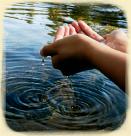 Since you need water while hiking, you'll either need to carry it or find it. If you find it, you'll need to treat it and then carry it, so carrying water is just a part of hiking.
Since you need water while hiking, you'll either need to carry it or find it. If you find it, you'll need to treat it and then carry it, so carrying water is just a part of hiking.
Water weighs 1kg per liter which is about 8.3lb per gallon - that's heavy!
An old saying is, "a Pint's a Pound, the World Around."
A pint of water weighs about a pound. There are two cups in a pint, two pints in a quart, and 4 quarts in a gallon. Since water weighs so much and is so critical to life, we need to be able to carry what we need, but not much more than that.
Planning a hike route and knowing the reliable water sources is an important part of hiking. If I know there is water 5 miles down the trail, I will carry 2 liters instead of 4 since that is plenty to reach my next source. This saves me from carrying 2kg (4.5lb) of extra weight.
Efficient Water carries
The most efficient way to carry water is in the stomache. It is centered for balance, the container has no extra weight, and it's free. Unfortunately, it has a very limited holding capacity. To supplement the stomache, there are a handful of ways to carry hiking water, each with it's benefits. When choosing how you will carry water, keep these thoughts in mind:
- Balance - will the weight be balanced both side-to-side and front-to-back? Water sitting on the face of the pack furthest from your body will be extremely uncomfortable. Weight hanging off one side will make the muscles in the other side tire faster.
- Stability - a 2-pound weight swinging back and forth off a pack disrupts the normal hiking rhythm. Make sure the water containers are securely fastened or packed inside so they do not swing and sway their way down the trail.
- Excess Weight - the water container itself adds extra weight to a pack. Carrying 2 pounds of water inside a 2-pound clay pot is not efficient. Minimizing the container to water weight ratio helps us work less to transport more water.
- Ease of Use - being able to easily get to the water to drink and easily refill the water is important. If I have to stop and remove my pack every time I want a drink of water, that isn't fun.
- Sanitation - over time, a container needs to be cleaned or stuff will grow in it.
With balance, stability, weight, ease of use, and sanitation in mind, here are a few common ways to carry water while hiking on the trail:
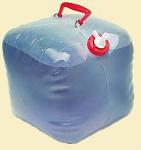 collapsible plastic jug - a simple jug is great for carrying a large amount of water. It is inexpensive and collapses when not in use so it takes up little space. There is little extra container weight compared to the amount of water carried. It is intended mostly for short hauls such as bringing water from the source to camp, not for carrying mile after mile. Simple to wash and dry.
collapsible plastic jug - a simple jug is great for carrying a large amount of water. It is inexpensive and collapses when not in use so it takes up little space. There is little extra container weight compared to the amount of water carried. It is intended mostly for short hauls such as bringing water from the source to camp, not for carrying mile after mile. Simple to wash and dry.
Since it is carried in the hand, hiking is more difficult while carrying a jug. It's not very easy to get a drink from it, either.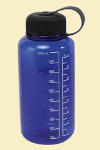 water bottle - 1-liter plastic bottle made specifically for hiking water. The well-known Nalgene name is synonymous with water bottle. They are practically indestructible in the wild, making them very popular. Two bottles provide enough water for about 10 miles of hiking. Two bottles, one on each side of a pack, provide balance. They are easy to reach and easy to fill. Alternating which bottle you drink from keeps the load balanced. Just wash in a dishwasher or by hand.
water bottle - 1-liter plastic bottle made specifically for hiking water. The well-known Nalgene name is synonymous with water bottle. They are practically indestructible in the wild, making them very popular. Two bottles provide enough water for about 10 miles of hiking. Two bottles, one on each side of a pack, provide balance. They are easy to reach and easy to fill. Alternating which bottle you drink from keeps the load balanced. Just wash in a dishwasher or by hand.
I've often seen them attached to packs by their lid loop causing them to swing freely which makes hiking more difficult. The fact that they are indestructible means they are also heavy and lose on the water weight ratio criteria.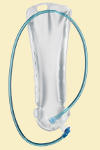 water bladder - Camelbak and Platypus are well-known but now there are dozens of brands making flexible hydration systems. They range in size, usually 1-liter to 3-liter. The bladders ride in the pack next to the hiker so are well balanced. A drink hose makes drinking while hiking extremely easy and may help hikers drink more, staying better hydrated. They are extremely stable, being completely packed in, and they tend to be light compared to the water they carry.
water bladder - Camelbak and Platypus are well-known but now there are dozens of brands making flexible hydration systems. They range in size, usually 1-liter to 3-liter. The bladders ride in the pack next to the hiker so are well balanced. A drink hose makes drinking while hiking extremely easy and may help hikers drink more, staying better hydrated. They are extremely stable, being completely packed in, and they tend to be light compared to the water they carry.
Water bladders are a pain to fill because they need to be removed from the pack and then repacked. They can fairly easily get punctured. It is difficult to determine how much water is left in the bladder, or if the user is actually drinking enough water. Bladders are washed by hand and can be difficult to dry completely, especially the drinking hose. They also tend to be expensive for the amount of water they carry.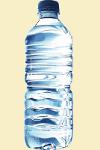 disposable bottle - Any bottled water or sport drink bottle can be reused instead of thrown away. They are free, durable, and extremely lightweight. They come in any size from 300ml to over 2 liters. They can be stored inside or around your pack so balance is good and flexible. Sanitation is not a concern because they can be recycled instead of cleaned.
disposable bottle - Any bottled water or sport drink bottle can be reused instead of thrown away. They are free, durable, and extremely lightweight. They come in any size from 300ml to over 2 liters. They can be stored inside or around your pack so balance is good and flexible. Sanitation is not a concern because they can be recycled instead of cleaned.
It is possible to rupture a disposable bottle, but it takes some effort.
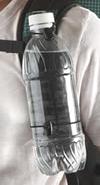 Here is an efficient way to carry water.
Here is an efficient way to carry water.Since the weight of the pack is pulling backwards, putting weight on the front helps equalize that pull and makes a more comfortable hike. Water is probably the most dense item being carried, so carrying it on the front pack straps is a great idea.
The water offsets the pack weight and is easily accessible for drinking. I've seen some people adapt the bottle lid so it has a straw for drinking while hiking - seems pretty cool to me!
All Comments:
Feb 12, 2014 - 'Grizz'
Jun 09, 2014 - Marie
Jun 09, 2014 - Hiking Dude
Feb 26, 2015 - Greg Smith
Mar 19, 2015 - WyoTrekker
Mar 23, 2015 - Hiking Dude
Sep 07, 2015 - becfoot
Dec 07, 2015 - Nova
Mar 02, 2016 - doghiker
Apr 26, 2016 - Rick scott
Apr 26, 2016 - Hiking Dude
If I had to do that (which I never would), I would divide it into 3 or 4 containers just in case one failed.
Aug 12, 2016 - Tim Moe
Aug 12, 2016 - Hiking Dude
Feb 16, 2018 - Geoff Gafford
Apr 20, 2018 - kathie
THanks,
Apr 25, 2018 - Hiking Dude
Mar 10, 2021 - Joe
Ask a Question
Find more Hiking Resources at www.HikingDude.com


 Planning your Food
Planning your Food Building your Skills
Building your Skills
Follow Me
Recent Comments